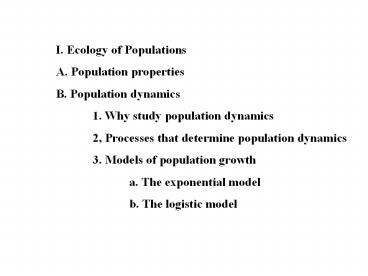I. Ecology of Populations - PowerPoint PPT Presentation
Title:
I. Ecology of Populations
Description:
1. Why study population dynamics. 2, Processes that determine ... Nesting gannets. King penguins. Populations with uniform. dispersion patterns. Fig. 52.2 ... – PowerPoint PPT presentation
Number of Views:296
Avg rating:3.0/5.0
Title: I. Ecology of Populations
1
I. Ecology of Populations A. Population
properties B. Population dynamics 1. Why study
population dynamics 2, Processes that determine
population dynamics 3. Models of population
growth a. The exponential model b. The
logistic model
2
Ecology
the study of the distribution and abundance of
organisms
3
Populations with clumped dispersion patterns
4
Populations with uniform dispersion patterns
King penguins
Nesting gannets
5
Fig. 52.2
6
?N/?t B D I E
eaths
irths
mmigration
migration
7
dN/dt rN
r gt 0 population will grow r 0 population
wont change r lt 0 population will shrink
8
Fig. 52.8 The exponential model for population
growth
9
Using the exponential model to predict population
size in the future
Nt N0 ert Nt Number of individuals in
the population at time t N0 Number of
individuals in the population at start E base
of natural logs r per capita rate of increase t
time If you know N0 and r, you can predict Nt
10
dN/dt r N (K - N)/K
For r0.1 K100 if N 10 dN/dt .1 (10)
(100 - 10)/100 .1 (10) (.9)
.9 if N 99 dN/dt .1 (99) (100 -
99)/100 .1 (99) (.01) .099
11
Fig. 52.11 The patterns of exponential and
logistic population growth































